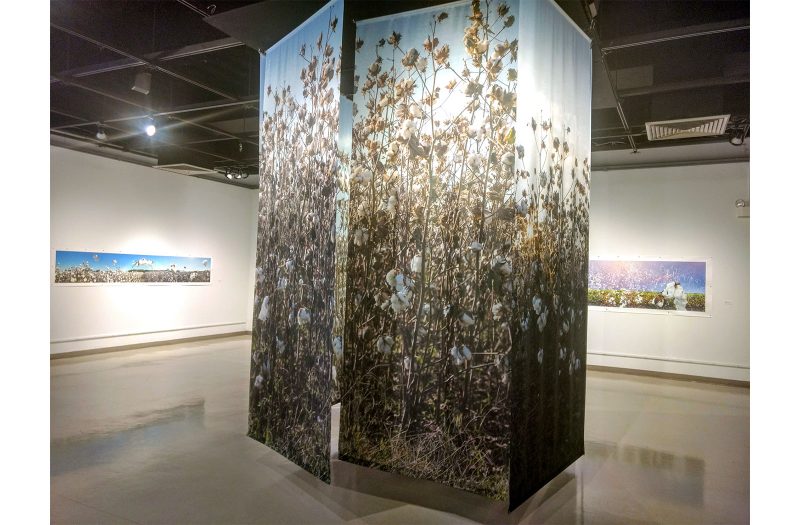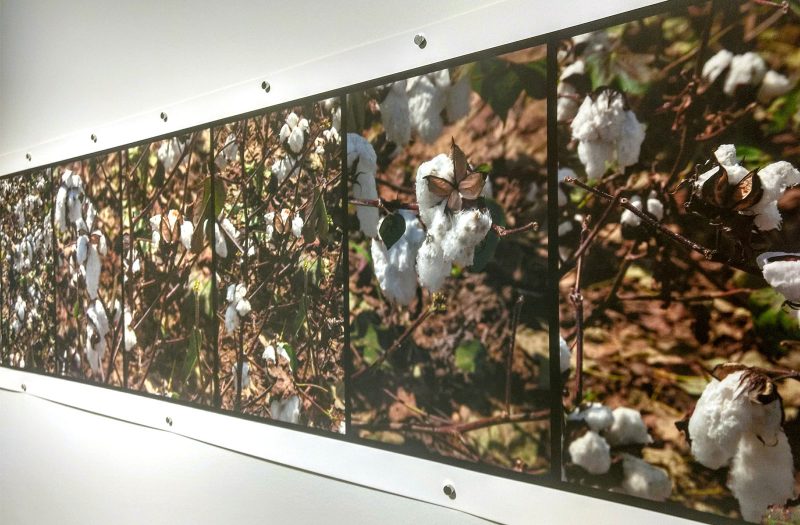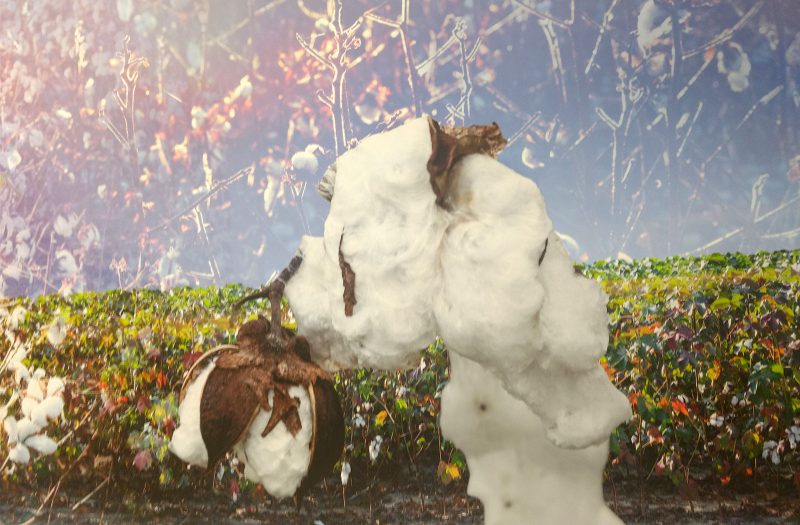John Dowell’s Cotton: The Soft, Dangerous Beauty of the Past on view at the African American Museum of Philadelphia is a multi-sensory experience that pulls visitors in through strong visuals and attentive listening.

North and South
One cannot dismiss the unhealed wounds that slavery has burned into the fabrics of America and other countries around the world. Dowell articulately combines two mediums — photography and printmaking — to develop complex dialogue on cotton and its role in history. Cotton occupies either the pinnacle focus or relegates into the background as a secondary element, collaged alongside digital drawings and strategic bold text. The most intriguing compositions superimpose cloud-like cotton over images of young black Harlem residents reading and dreaming. Dowell’s research on Seneca Village — a 19th century settlement of free blacks upon which Central Park was built — provides a significant parallel to the current turmoil of Harlem’s gentrification. In The Poet, a child holds a white paged book and a microphone. Rows and rows of sunlit cotton around him suggest spiritual reverence and emotional homage. The abundant, personified cotton serves as audience, attentive and affectionate to the orator.
I spoke with Dowell adjacent to Lost in Cotton, a constructed maze of digital prints on hanging strips of taffeta. “When my grandmother was a little girl, she got lost in a field of cotton,” he explained. “Down outside Augusta, technically South Carolina, cotton grows five feet tall, which is very rare.” A sign asks the spectator to enter the maze between the strips and move clockwise towards the open center. Once inside, splendorous high cotton portraits surround and confound the tight space, resonating with the psychological plight of Dowell’s lost and petrified ancestor.
A celebration of survival
“I’m using cotton as a symbol for the black body and the actual places [black bodies occupied].” Dowell uses cotton — one of the most humiliating symbols of slavery — to uphold and celebrate black survival. Fertility, strength, and healing are united in jarring closeups of plump cotton bolls that leap from saturated archival prints while soft, haunting hymns and work songs drift in the background.
Dowell’s digital prints range in scale from framed mid-sized pieces to massive panoramic shots on unstretched canvas. These compelling cotton landscapes eulogize the forgotten, the voiceless. He has captured and bestowed new meanings, redefining the cause of tremendous, generational pain. For example, Up Close is a sophisticated compilation, a sequential medley of images combining striking saturated colors and intense shots of cotton thriving in nature. Butterflies situate atop the snowy whiteness, marigold and black wings enhancing the stark, ordinary cotton.

Space for reflection
In a nook on the third floor, there is an area to rest and draw breath, to reminisce, to hold and feel the weightlessness of cotton and its brittle leaves. Viewers are also allowed to bring in old photographs and place them on the altar framed by tall cotton plants, to honor their families in a collective embrace.
Dowell’s Cotton: The Soft, Dangerous Beauty of the Past is awe and sustenance, a reflection on a fluffy plant and its grisly impact on past and present black lives. The whole breadth of this sincere and educational show is a love letter addressed to the wonders of the human condition — a love letter that confesses yearning, compassion, and victory.
“Cotton: The Soft, Dangerous Beauty of the Past” is on view September 15, 2018 — January 21, 2019 at The African American Museum of Philadelphia, 701 Arch St, Philadelphia, PA, 19106. Museum hours are Wednesday thru Saturday 10-5pm and Sunday 12-5pm. Contact AAMP at (215) 574-0380.






